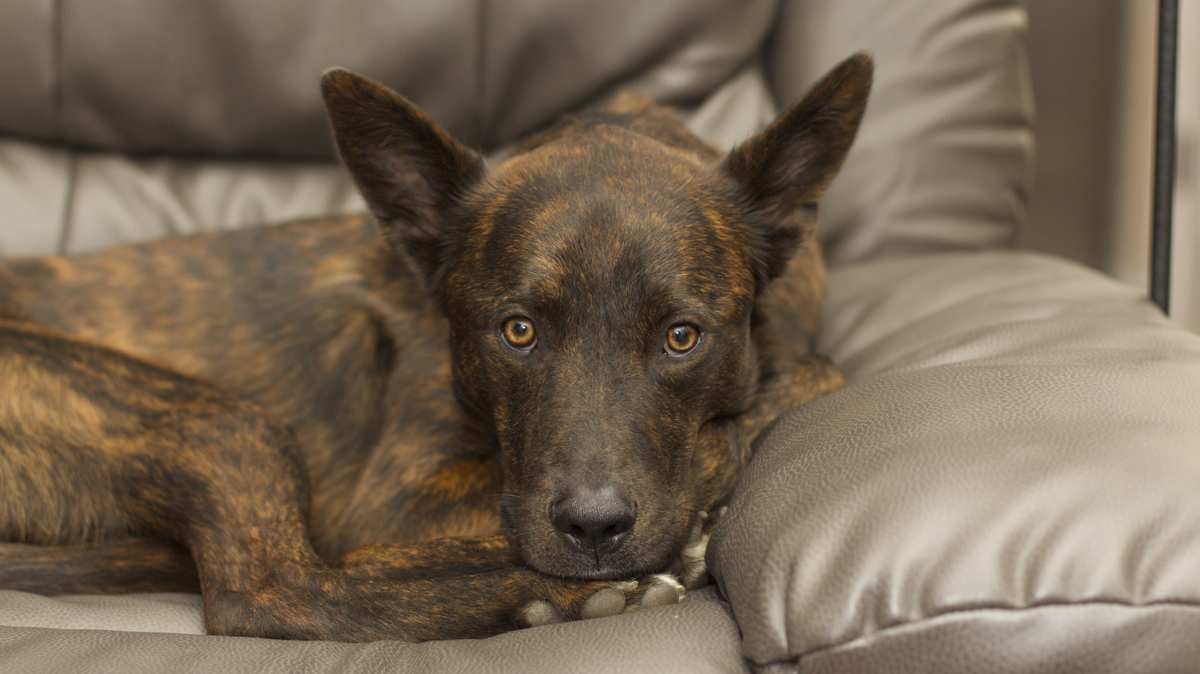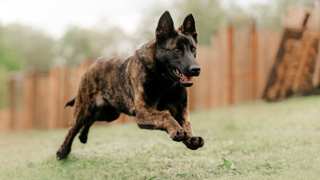Dutch Shepherd Dog
Dutchie
Hollandse Herdershond
The Dutch Shepherd is a working breed native to Eastern Europe. Closely resembling the German and Belgian Shepherds (both of which are genetically similar) in size and stature, this breed is an intelligent, working-class animal with an affectionate nature, factors that make it a remarkable family companion. Dutch Shepherds are also extremely trainable, and are regularly utilized by police units and search-and-rescue teams.
Dutch Shepherd Breed Details
The Dutch Shepherd, a member of the Herding group of breeds, was developed in Europe in the eighteenth century to be a working farm dog. These animals are great, obviously, for livestock owners in need of a shepherd dog, but the make good companions for active families as well. A few Dutch Shepherd facts: they're medium-sized, have either long, short, or wiry coats, and are typically brindle in color. Here are some pros and cons of the breed:
PROS:
- Intelligent
- Extremely intuitive and goal-oriented
- Fairly low-maintenance
- Incredibly athletic
- Affectionate and loyal
- Easy to train
- Very healthy
- Great watch- and guard dog abilities (but a Dutch Shepherd will attack only if trained to do so)
- Socializes well with kids and other animals
- Excels in obedience and agility trials
CONS:
- High activity requirements
- Can be bossy or dominant if not trained properly
- Sheds heavily during shedding season (especially the long-haired variety)
- Because of herding instincts, may attempt to herd or "nudge" kids, joggers, or bicyclists
- May turn mischievous and destructive if bored
Purebred
12 - 15 yrs.
21 - 24 in.
50 - 70 lbs
OverallFamily FriendlyChild FriendlyPet FriendlyStranger Friendly
Easy to GroomEnergy LevelExercise NeedsHealthShedding Amount
Barks / HowlsEasy to TrainGuard DogPlayfulnessWatch Dog
Apartment DogCan be AloneGood for Busy OwnersGood for New OwnersIntelligence
Dutch Shepherd Breed Description
A medium-sized breed; weight is 50-70 pounds, and height is 21-24 inches at the shoulders.
Known as one of the most well-balanced of all dog breeds, the Dutch Shepherd is intelligent, athletic, affectionate, and protective, and will make an excellent family pet. These dogs have a strong work ethic and friendly personalities, and are often used by police K9 units and as service dogs for disabled people.
These are low-maintenance dogs, and will require little grooming or training.
Dutch Shepherd Breed History
The Dutch Shepherd originated in Eastern Europe, where it has existed for centuries. This breed is closely related to both the German Shepherd and the Belgian Shepherd; the Dutch and Belgian Shepherds are so genetically similar, in fact, that some argue that they are simply variants of the same breed. As Europe grew in population in the eighteenth and nineteenth centuries, these three shepherd breeds also diversified, and the Dutch Shepherd became especially popular in the Netherlands (which likely explains the origin for the breed's name) as a versatile working dog. Dutch culture of the 1800s was largely agricultural, so Dutch Shepherds were used to tend sheep, among other livestock; in particular, these dogs patrolled the borders of the crop fields, and prevented the sheep from eating them. Around 1900, the Nederlandse Herdershonden Clube, the official Dutch club for Dutch Shepherd owners, published the first breed standard for these dogs.
With the advent of more modern farming techniques, the need for this breed as a working farm dog decreased dramatically, so Dutch Shepherds shrank in number in the Netherlands and elsewhere during the early twentieth century; when Europe was ravaged by World War II, Dutch Shepherds nearly became extinct. But in the later 1900s, breed clubs worldwide revived its existence, though it is still somewhat rare even today.
Dutch Shepherd Appearance
This breed has three different coat types: short, long, and wiry. A Dutch Shepherd's athletic, well-toned body is normally a bit greater in length than in height. The head is wedge-shaped, with a somewhat flat skull and a medium-length muzzle; the eyes are wide-set, almond-shaped, and medium-sized; the triangular ears are medium-sized, somewhat forward-facing, and carried erect. This breed's chest is somewhat narrow, but fairly deep. The legs are of medium length, with straight forelegs and backward-angled hind legs; the tail is long, quite thick, and curves slightly.
The images below represent the coat colors and patterns associated with Dutch Shepherds.
Dutch Shepherd Variations
Dutch Shepherds share many hereditary traits with the German and Belgian Shepherds--so much so that some people contend that the three are simply varieties of the same breed. Within the Dutch Shepherd breed itself, though, there is little variation in physical structure.
There is, however, some variety in coat types for dogs of this breed. Most of the coats are brindle in color, with one of three textures:
- Short: A short-haired Dutch Shepherd has fur that is quite hard to the touch; though still considered "short," the fur length is approaching medium.
- Long: Straight, flat, and rough to the touch, a long-haired Dutch Shepherd is less common than the short-haired variety.
- Wiry: A wire-haired Dutch Shepherd has medium-length fur that is actually more curly than it is wiry; these coats have a ruffled, unkempt look.
Dutch Shepherd Temperament
Intelligent, athletic, loyal, and intuitive, the Dutch Shepherd is an affectionate animal that is extremely easy to train – a combination of traits that makes it a fantastic family pet. An active and alert breed, these dogs, as is their farm-dog heritage, are enthusiastic workers; police forces, disabled people, and emergency organizations regularly employ Dutch Shepherds because of their versatility, outstanding work ethic and trainability. As a shepherd breeds, they are instinctively protective of people, other pets, and property, so they will make excellent watchdogs; this protective nature, though, can sometimes lead to dominant and bossy behavior, so a Dutch Shepherd will need consistent training, along with early socialization with people and other pets, to help it learn its proper place in the family "pack."
Dutch Shepherd Maintenance
Dutch Shepherds are fairly low-maintenance animals. Little grooming will be necessary; not much training will be required (and will be extremely easy); a moderate amount of exercise will be needed.
Despite having three different coat types, all Dutch Shepherds require the same amount of grooming – and they don't require much. Brushing (or in the case of the wiry coat, combing) should be performed weekly to remove any dead hair; these dogs' coats are naturally water-resistant, so bathing should only occur when absolutely necessary, as baths remove the natural waterproofing oils from the coat.
These active, athletic dogs need a good deal of physical stimulation. Daily outdoor activities like Frisbee and fetch are great, as is an hour-long daily walk.
If provided with enough exercise, a Dutch Shepherd should adapt to any living situation, whether house or apartment.
Life expectancy is 12-15 years. This breed has no known major health issues; occasionally, these dogs suffer from minor hip or elbow dysplasia.



